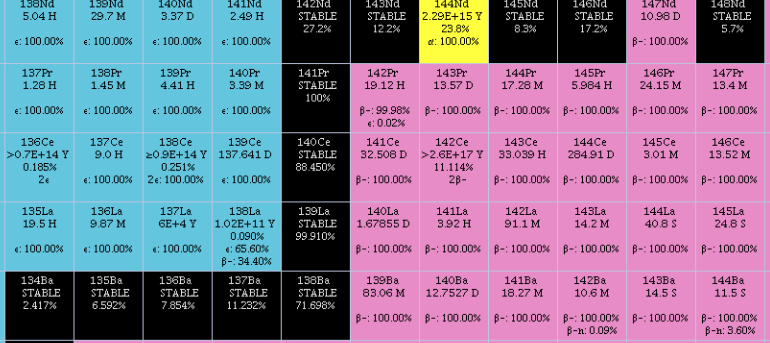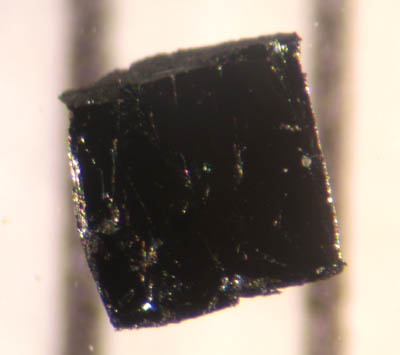|
Lanthanum Decahydride
Lanthanum decahydride is a polyhydride or superhydride compound of lanthanum and hydrogen (LaH10) that has shown evidence of being a high-temperature superconductor. It was the first metal superhydride to be theoretically predicted, synthesized, and experimentally confirmed to superconduct at near room-temperatures. It has a superconducting transition temperature TC around at a pressure of , and its synthesis required pressures above approximately . Synopsis Since its discovery in 2019, the superconducting properties of LaH10 and other lanthanum-based superhydrides have been experimentally confirmed in multiple independent experiments. The compound exhibits a Meissner effect below the superconducting transition temperature. A cubic form can be synthesized at , and a hexagonal crystal structure can be formed at room temperature. Further reports indicate Tc is increased with nitrogen doping, and decreased with the introduction of magnetic impurities. The cubic form has each lanthanu ... [...More Info...] [...Related Items...] OR: [Wikipedia] [Google] [Baidu] |
Polyhydride
A polyhydride or superhydride is a compound that contains an abnormally large amount of hydrogen. This can be described as high hydrogen stoichiometry. Examples include iron pentahydride , , and . By contrast, the more well known lithium hydride only has one hydrogen atom. Polyhydrides are only known to be stable under high pressure. Polyhydrides are important because they can form substances with a very high density of hydrogen. They may resemble the elusive metallic hydrogen, but can be made under lower pressures. One possibility is that they could be superconductors. Hydrogen sulfide under high pressures forms units, and can be a superconductor at and a pressure of 1.5 million Atmosphere (unit), atmospheres (152 GPa). Structures The polyhydrides of Alkaline earth metal, alkaline earth and alkali metals contain cage structures. Also hydrogen may be clustered into , , or units. Polyhydrides of transition metals may have the hydrogen atoms arranged around the metal atom. Comp ... [...More Info...] [...Related Items...] OR: [Wikipedia] [Google] [Baidu] |
Lanthanum
Lanthanum is a chemical element; it has symbol La and atomic number 57. It is a soft, ductile, silvery-white metal that tarnishes slowly when exposed to air. It is the eponym of the lanthanide series, a group of 15 similar elements between lanthanum and lutetium in the periodic table, of which lanthanum is the first and the prototype. Lanthanum is traditionally counted among the rare earth elements. Like most other rare earth elements, its usual oxidation state is +3, although some compounds are known with an oxidation state of +2. Lanthanum has no biological role in humans but is used by some bacteria. It is not particularly toxic to humans but does show some antimicrobial activity. Lanthanum usually occurs together with cerium and the other rare earth elements. Lanthanum was first found by the Swedish chemist Carl Gustaf Mosander in 1839 as an impurity in cerium nitrate – hence the name ''lanthanum'', from the ancient Greek (), meaning 'to lie hidden'. Although ... [...More Info...] [...Related Items...] OR: [Wikipedia] [Google] [Baidu] |
Meissner Effect
In condensed-matter physics, the Meissner effect (or Meißner–Ochsenfeld effect) is the expulsion of a magnetic field from a superconductor during its transition to the superconducting state when it is cooled below the critical temperature. This expulsion will repel a nearby magnet. The German physicists Walther Meissner, Walther Meißner (anglicized ''Meissner'') and Robert Ochsenfeld discovered this phenomenon in 1933 by measuring the magnetic field distribution outside superconducting tin and lead samples. The samples, in the presence of an applied magnetic field, were cooled below their Superconductivity#Superconducting phase transition, superconducting transition temperature, whereupon the samples cancelled nearly all interior magnetic fields. They detected this effect only indirectly because the magnetic flux is conserved by a superconductor: when the interior field decreases, the exterior field increases. The experiment demonstrated for the first time that superconducto ... [...More Info...] [...Related Items...] OR: [Wikipedia] [Google] [Baidu] |
Nitrogen
Nitrogen is a chemical element; it has Symbol (chemistry), symbol N and atomic number 7. Nitrogen is a Nonmetal (chemistry), nonmetal and the lightest member of pnictogen, group 15 of the periodic table, often called the Pnictogen, pnictogens. It is a common element in the universe, estimated at Abundance of the chemical elements, seventh in total abundance in the Milky Way and the Solar System. At standard temperature and pressure, two atoms of the element chemical bond, bond to form N2, a colourless and odourless diatomic molecule, diatomic gas. N2 forms about 78% of Atmosphere of Earth, Earth's atmosphere, making it the most abundant chemical species in air. Because of the volatility of nitrogen compounds, nitrogen is relatively rare in the solid parts of the Earth. It was first discovered and isolated by Scottish physician Daniel Rutherford in 1772 and independently by Carl Wilhelm Scheele and Henry Cavendish at about the same time. The name was suggested by French chemist ... [...More Info...] [...Related Items...] OR: [Wikipedia] [Google] [Baidu] |
Chamfered Cube
In geometry, a chamfer or edge-truncation is a topological operator that modifies one polyhedron into another. It separates the Face (geometry), faces by reducing them, and adds a new face between each two adjacent faces (moving the vertices inward). Oppositely, similar to Expansion (geometry), expansion, it moves the faces apart outward, and adds a new face between each two adjacent faces; but contrary to expansion, it maintains the original Vertex (geometry), vertices. For a polyhedron, this operation adds a new hexagonal face in place of each original Edge (geometry), edge. In Conway polyhedron notation, ''chamfering'' is represented by the letter "c". A polyhedron with edges will have a chamfered form containing new vertices, new edges, and new hexagonal faces. Chamfered Platonic solids Chamfers of five Platonic solids are described in detail below. Each is shown in an Equilateral polygon, equilateral version where all edges have the same length, and in a canonic ... [...More Info...] [...Related Items...] OR: [Wikipedia] [Google] [Baidu] |
Lanthanum Boron Octahydride
Lanthanum is a chemical element; it has symbol La and atomic number 57. It is a soft, ductile, silvery-white metal that tarnishes slowly when exposed to air. It is the eponym of the lanthanide series, a group of 15 similar elements between lanthanum and lutetium in the periodic table, of which lanthanum is the first and the prototype. Lanthanum is traditionally counted among the rare earth elements. Like most other rare earth elements, its usual oxidation state is +3, although some compounds are known with an oxidation state of +2. Lanthanum has no biological role in humans but is used by some bacteria. It is not particularly toxic to humans but does show some antimicrobial activity. Lanthanum usually occurs together with cerium and the other rare earth elements. Lanthanum was first found by the Swedish chemist Carl Gustaf Mosander in 1839 as an impurity in cerium nitrate – hence the name ''lanthanum'', from the ancient Greek (), meaning 'to lie hidden'. Although it i ... [...More Info...] [...Related Items...] OR: [Wikipedia] [Google] [Baidu] |
High-temperature Superconductors
High-temperature superconductivity (high-c or HTS) is superconductivity in materials with a critical temperature (the temperature below which the material behaves as a superconductor) above , the boiling point of liquid nitrogen. They are "high-temperature" only relative to previously known superconductors, which function only closer to absolute zero. The first high-temperature superconductor was discovered in 1986 by IBM researchers Georg Bednorz and K. Alex Müller. Although the critical temperature is around , this material was modified by Ching-Wu Chu to make the first high-temperature superconductor with critical temperature . Bednorz and Müller were awarded the Nobel Prize in Physics in 1987 "for their important break-through in the discovery of superconductivity in ceramic materials". Most high-c materials are type-II superconductors. The major advantage of high-temperature superconductors is that they can be cooled using liquid nitrogen, in contrast to previously k ... [...More Info...] [...Related Items...] OR: [Wikipedia] [Google] [Baidu] |





